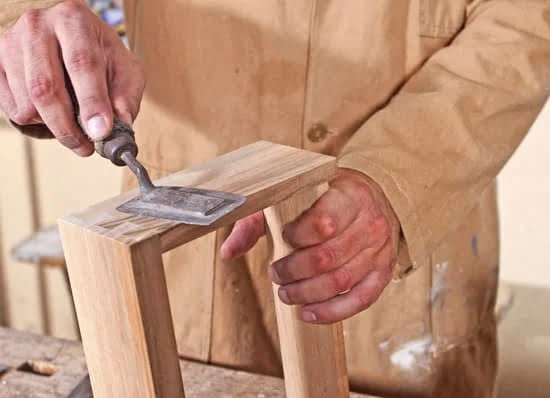Woodworking clamps are a must-have tool for any woodworker, whether you’re a beginner or an experienced craftsman. These clamps play a crucial role in ensuring accuracy and stability in woodworking projects of all sizes. They provide the necessary pressure to hold pieces of wood firmly together, allowing you to work with precision and confidence.
In any woodworking project, maintaining precise measurements is essential. Woodworking clamps are designed to keep your workpieces secure, preventing them from shifting or moving during the cutting, sanding, or joining process. Without these clamps, even the most skilled woodworker would struggle to achieve accurate and professional-looking results.
When it comes to woodworking clamps, quality is key. High-quality clamps offer better grip strength and durability, ensuring they can withstand the pressures associated with woodworking operations. Investing in reliable and well-constructed clamps will not only enhance your woodworking experience but also contribute to the longevity of your tools.
In this article, we will explore the various types of woodworking clamps available in the market and their specific applications. We will also discuss important factors that should be considered before purchasing clamps, such as size, weight, material quality, and gripping mechanisms. Additionally, we’ll provide insights on top brands and manufacturers known for producing high-quality clamps.
Whether you’re a seasoned woodworker looking to upgrade your clamp collection or a beginner just starting your woodworking journey, this comprehensive guide aims to help you make informed decisions when buying woodworking clamps. So let’s dive into the world of woodworking clamps and discover how these indispensable tools can elevate your craftmanship to new heights.
Types of Woodworking Clamps
Woodworking clamps come in various types, each designed to serve a specific purpose in different woodworking projects. In this comprehensive guide, we will explore the different types of woodworking clamps available in the market and discuss their specific functions and uses.
One popular type of woodworking clamp is the bar clamp. Bar clamps are versatile and can be used for a wide range of projects. They consist of a long metal bar with an adjustable sliding jaw attached at one end. The sliding jaw can be moved along the length of the bar to apply pressure on the workpiece, holding it securely in place. These clamps are commonly used for gluing, assembly work, and securing large panels.
Another common type is the C-clamp. C-clamps have a simple yet effective design, with a fixed jaw shaped like the letter “C” and a threaded screw that allows for adjustable pressure. They are typically used for light to medium-duty tasks such as securing small pieces or clamping parts together during assembly. C-clamps come in various sizes to accommodate different workpiece thicknesses.
Parallel clamps are also widely used in woodworking. These clamps feature two parallel jaws that distribute pressure evenly across the surface being clamped, minimizing distortion or damage to the workpiece. Parallel clamps provide excellent strength and stability, making them ideal for heavy-duty tasks like joining boards or assembling cabinets.
Other types of woodworking clamps include pipe clamps, spring clamps, hand screw clamps, and band clamps. Each has its own unique features and applications, catering to specific woodworking needs.
By understanding the different types of woodworking clamps available, woodworkers can choose the right clamp for their specific project requirements. Whether it’s holding pieces together during glue-ups or providing stability during complex joinery tasks, having the appropriate clamp on hand ensures accuracy, stability, and overall project success.
Factors to Consider Before Buying Woodworking Clamps
When it comes to buying woodworking clamps, there are several important factors to consider in order to make the right choice for your specific woodworking projects. By taking these factors into account, you can ensure that you are purchasing clamps that will provide the necessary stability and accuracy required for successful woodworking.
One of the first factors to consider is the size and weight of the clamps. Different projects require different clamp sizes and weights, so it’s important to choose clamps that match your project requirements. For smaller projects, such as crafts or small furniture pieces, lightweight clamps may be sufficient. However, larger projects like cabinets or tables may require heavier-duty clamps for added stability.
Another important consideration is the material and gripping mechanism of the clamps. Look for clamps made from durable materials, such as steel or aluminum, that can withstand frequent use without bending or breaking. Additionally, consider the type of gripping mechanism the clamp uses. Some common options include screw-threaded handles, quick-release triggers, or squeeze handles. Choose a mechanism that feels comfortable to use and provides a secure grip on your workpiece.
Before making a final decision on which woodworking clamps to purchase, it’s also helpful to read reviews and compare different brands and manufacturers. Look for renowned brands that are known for their quality craftsmanship and reliable products. Reading reviews from other woodworkers can give you valuable insights into how well specific clamps perform in real-world situations.
Overall, by considering factors such as size and weight, material and gripping mechanism, and researching different brands and manufacturers, you can choose woodworking clamps that are best suited for your needs. Taking the time to make an informed decision will ultimately result in more successful woodworking projects with accurate and stable results.
Top Brands and Manufacturers of Woodworking Clamps
Woodworking clamps are essential tools for any woodworking project, providing accuracy and stability during the construction process. When it comes to purchasing woodworking clamps, it is important to choose reliable brands that produce high-quality products. In this section, we will highlight some of the top brands and manufacturers known for their craftsmanship in producing woodworking clamps.
One highly regarded brand in the industry is Bessey. With over 125 years of experience, Bessey offers a wide range of woodworking clamps that are known for their durability and precision. Their clamps feature innovative designs and high-quality materials, making them a favorite among woodworkers.
Another reputable brand is Jorgensen. Established in 1901, Jorgensen is known for its sturdy yet versatile woodworking clamps. They offer various types of clamps, including bar clamps and hand screw clamps, which are popular choices among professionals and hobbyists alike.
For those looking for specialized woodworking clamps for specific tasks, Dubuque Clamp Works is a noteworthy brand to consider. They specialize in providing high-quality hand screw wood vises that are perfect for holding intricate wooden pieces securely during delicate operations.
| Brand | Years of Experience | Specialty |
|---|---|---|
| Bessey | Over 125 years | Durability and Precision |
| Jorgensen | Over 120 years | Versatility and Sturdiness |
| Dubuque Clamp Works | Over XX years | Specialized Hand Screw Wood Vises |
These are just a few of the many reputable brands and manufacturers in the market. By choosing woodworking clamps from these esteemed companies, woodworkers can ensure that they are investing in reliable and high-quality tools that will enhance their woodworking experience and project outcomes.
Where to Buy Woodworking Clamps
Buying woodworking clamps can be a crucial decision for woodworkers, as the quality and reliability of these essential tools greatly impact the outcome of their projects. When it comes to purchasing woodworking clamps, there are two main options to consider: buying online or buying from physical stores. Each option has its advantages and disadvantages, and understanding them can help woodworkers make the best choice based on their preferences and needs.
Advantages of Buying Woodworking Clamps Online:
– Convenience: One of the biggest advantages of buying woodworking clamps online is convenience. Woodworkers can browse through a wide variety of options from the comfort of their own homes without needing to travel to physical stores.
– Price Comparison: Online platforms and websites offer an easy way to compare prices across different brands and sellers. This allows woodworkers to find the best deals and potentially save money on their clamp purchases.
– Wide Selection: Online stores typically have a larger selection of woodworking clamps compared to physical stores. This means that woodworkers have access to a wider range of brands, types, sizes, and features, increasing the likelihood of finding the perfect clamp for their specific needs.
Disadvantages of Buying Woodworking Clamps Online:
– Inability to Inspect: One disadvantage of buying woodworking clamps online is that you cannot physically inspect or test the product before purchasing. While product descriptions, images, and customer reviews provide some information, it may not be enough for some woodworkers who prefer hands-on evaluation.
– Shipping Time: Depending on the seller’s location and shipping method chosen, woodworkers may need to wait for their order to arrive if they purchase clamps online. This can be inconvenient when time-sensitive projects are at hand.
– Lack of Personalized Assistance: When buying online, woodworkers miss out on the personalized assistance that physical stores can offer. In physical stores, sales representatives can provide guidance and answer questions, helping woodworkers make an informed decision.
For those who prefer a more hands-on approach or value immediate purchase gratification, buying woodworking clamps from physical stores may be the preferred option. Physical stores allow woodworkers to inspect the clamps in person, ensuring they meet their quality standards. Additionally, knowledgeable staff members are often available to provide personalized assistance and recommendations based on the specific projects and needs of the woodworker.
Ultimately, whether choosing to buy online or offline, it is important for woodworkers to do thorough research, read reviews, and consider their own preferences before making a decision. By weighing the advantages and disadvantages of each option against their individual needs, woodworkers can make an informed choice that best suits their woodworking requirements.
| Advantages of Buying Woodworking Clamps Online | Disadvantages of Buying Woodworking Clamps Online |
|---|---|
| Convenience | Inability to Inspect |
| Price Comparison | Shipping Time |
| Wide Selection | Lack of Personalized Assistance |
How to Choose the Perfect Woodworking Clamps for Your Projects
Choosing the perfect woodworking clamps for your projects is crucial in achieving accurate and stable results. With the wide variety of clamps available in the market, it can be overwhelming to determine which ones will best suit your specific woodworking needs. In this section, we will discuss important factors to consider when selecting the right clamps for your projects, provide handy tips and suggestions for beginners, and discuss the ideal clamp quantities for different project sizes.
Factors to Consider
When choosing woodworking clamps, there are several factors that you should keep in mind. One important consideration is the size and weight of the clamps. Depending on your project requirements, you may need larger or heavier clamps to provide enough pressure for gluing or clamping pieces together.
It is also essential to choose clamps that have durable materials and reliable gripping mechanisms. Cheap or low-quality clamps may not provide adequate stability or longevity, so investing in high-quality clamps will save you time and frustration in the long run.
Tips for Beginners
For beginners just starting their woodworking journey, selecting the first set of clamps can be daunting. It is recommended to start with a few basic types of clamps that cover a range of functions. These can include bar clamps, pipe clamps, and spring clamps. As you gain experience and take on more complex projects, you can gradually expand your collection with specialized clamps such as edge clamps or corner clamps.
It is also advisable to seek advice from experienced woodworkers or consult reputable sources such as online forums or woodworking communities. They can offer valuable insights based on their own experiences and help steer you towards suitable clamp options for specific projects.
Ideal Clamp Quantities
The number of clamps needed for a project depends on its size and complexity. As a general guideline, it is recommended to have at least two parallel-clamping bar or pipe clamps for every foot of material being clamped. This ensures even pressure distribution and prevents warping or distortion during glue-ups.
For smaller projects, having a variety of sizes and types of clamps can be advantageous. This allows for more versatility and ensures that you have the right tool for each unique task. It is essential to assess your project requirements and plan accordingly to ensure a successful woodworking experience.
By considering these factors, following practical tips, and determining the ideal clamp quantities, you can confidently choose the perfect woodworking clamps for your projects. Remember that investing in high-quality clamps will not only enhance your woodworking experience but also contribute to the overall success and satisfaction of your finished products.
Tips and Techniques for Properly Using Woodworking Clamps
Woodworking clamps are essential tools for any woodworker, but knowing how to use them properly is equally important. In this section, we will provide some valuable tips and techniques for effectively utilizing woodworking clamps during your woodworking operations.
- Correct Positioning: One of the key aspects of using clamps effectively is positioning them correctly. Make sure to position the clamp in a way that exerts pressure in the direction that you want the joint to come together. Additionally, it is important to evenly distribute the pressure along the entire length of the joint for optimal results.
- Application Techniques: Different woodworking projects may require different application techniques for clamps. For example, when gluing boards together, applying uniform pressure along the entire surface is crucial. This can be achieved by alternating clamps placed above and below the joint area.
- Avoid Common Mistakes: While using woodworking clamps, it is important to avoid common mistakes that can compromise their effectiveness. One common mistake is over-tightening the clamps, which can lead to warped or misaligned workpieces. To prevent this, apply just enough pressure to hold everything securely without causing any damage.
– Another mistake to avoid is insufficient padding between the clamp jaws and your workpiece. This can result in indentations or marks on your project. To prevent this, use scrap wood or soft materials like felt or leather pads as padding between the clamp jaws and your project.
By following these tips and techniques when using woodworking clamps, you can ensure optimal performance and achieve better results in your woodworking projects. Remember to always exercise caution and use protective equipment such as gloves and safety glasses while working with clamps.
For more detailed information on using specific types of clamps or advanced clamp techniques, consider referring to specialized woodworking resources or consulting experienced woodworkers who can offer valuable insights based on their expertise.
Reviews of Highly Recommended Woodworking Clamps
In this section, we will showcase a compilation of top-reviewed woodworking clamps available in the market. These reviews aim to provide readers with in-depth information about each recommended clamp, including their features, pros, and cons. By reading these reviews, readers can make a well-informed decision based on honest and unbiased opinions.
- Bessey BPC-H34 3/4-Inch H Style Pipe Clamp: This pipe clamp from Bessey has received rave reviews for its versatility and durability. It features a heavy-duty cast iron construction that ensures stability and strength during woodworking projects. The H style design provides maximum leverage for tightening and securing workpieces.
Users appreciate the large jaw faces that distribute pressure evenly without causing damage to the surface of the wood. The Bessey BPC-H34 is highly recommended for its excellent grip strength and overall performance. - Jorgensen Cabinet Master 24-Inch Parallel Jaw Bar Clamp: The Jorgensen Cabinet Master is highly regarded for its precise and consistent clamping pressure. Its parallel jaw design allows users to apply even pressure across the entire surface of the workpiece, resulting in flat glue-ups and reduced chances of misalignment.
The clamp has a quick release trigger that allows for easy positioning and removal of materials, saving time during woodworking tasks. Despite its premium quality, some users find the price point slightly high compared to other options on the market. - Irwin QUICK-GRIP One-Handed Bar Clamp/Spreader: As the name suggests, this bar clamp by Irwin is designed for quick and easy one-handed operation. Users appreciate its versatility as it can be used as both a clamp and spreader, making it ideal for a wide range of woodworking applications.
The innovative pistol grip design allows for comfortable usage while ensuring ample force is applied to hold materials firmly in place. While some reviewers mention that these clamps may not have the same gripping strength as heavier-duty options, they are highly recommended for their convenience and ease of use. - Pony Jorgensen 50 Clamp Fixture for ¾” Black Pipe: The Pony Jorgensen 50 Clamp Fixture is a popular choice among woodworkers due to its versatility. It can be used with standard 3/4-inch black pipe to create custom clamps of various lengths to suit different project requirements.
Users appreciate the ability to adjust the length of the clamp, allowing them to accommodate larger workpieces. The fixture has received praise for its solid construction and durability, while some users highlight that tightening the clamps requires extra effort compared to other types of woodworking clamps.
By considering these reviews, readers can gain valuable insights into the performance and features of different woodworking clamps. It is important to read multiple reviews and consider individual needs and preferences before making a final purchasing decision.
Conclusion
In conclusion, woodworking clamps are an essential tool for every woodworker. Throughout this article, we have highlighted the significance of woodworking clamps in any woodworking project and emphasized the necessity of high-quality clamps for accuracy and stability.
We have provided a comprehensive guide to the different types of woodworking clamps available in the market, discussing their specific functions and uses. This has helped readers understand which type of clamp suits their specific woodworking needs.
Before purchasing clamps, it is important to consider factors such as size, weight, material durability, and gripping mechanisms. We have explored these considerations in detail to help readers make an informed buying decision.
Additionally, we have showcased top brands and manufacturers known for their quality craftsmanship, providing information that will assist readers in choosing reliable options.
Furthermore, we have discussed the advantages and disadvantages of purchasing clamps online versus offline. Both options have their merits depending on personal preferences and project requirements.
To choose the perfect woodworking clamps for your projects, it is crucial to consider factors such as project size, beginner-friendly options, and ideal clamp quantities. These considerations will ensure optimal performance during your woodworking journey.
We have also provided tips and techniques for properly using woodworking clamps, giving insight into correct positioning and application techniques while avoiding common mistakes.
Finally, we have compiled a list of highly recommended woodworking clamps with in-depth reviews that discuss their features, pros, and cons. These reviews will assist readers in making well-informed decisions based on honest feedback from other users.
Frequently Asked Questions
Which woodworking clamps are best?
Determining the best woodworking clamps depends on the specific needs of the project and personal preferences. Some commonly recommended clamps include bar clamps, parallel clamps, C-clamps, pipe clamps, and hand screw clamps. Bar clamps are versatile and offer a good grip for a wide range of projects. Parallel clamps are known for their stability and ability to evenly distribute pressure.
C-clamps are handy for smaller tasks or when working with irregular shapes. Pipe clamps are popular for their affordability and adaptability to different lengths of pipes. Hand screw clamps provide a traditional and reliable hold, especially for delicate or small-scale projects. Ultimately, it is essential to choose woodworking clamps that meet the specific requirements of each project.
What clamps for beginner woodworking?
For beginners in woodworking, it is advisable to start with a collection of basic clamps that cater to most common needs. A combination of quick-grip bar clamps and C-clamps can be a good starting point. Quick-grip bar clamps are user-friendly with one-handed operation, making them ideal for holding pieces together during assembly or gluing tasks.
They come in various sizes to accommodate different workpiece thicknesses. C-clamps offer versatility and affordability while providing sufficient gripping power for many beginner projects such as attaching boards or securing pieces on a workbench. As beginners gain experience and tackle more complex projects, they may explore adding other types of clamps based on their evolving needs.
What clamps does Paul Sellers use?
Paul Sellers, a well-known woodworker and teacher, often uses a variety of traditional hand tools in his projects, including woodworking vises instead of conventional bar or pipe-style clamping devices commonly associated with modern woodworking shops. He emphasizes the use of wooden handscrews or bench screws as versatile clamp substitutes when necessary because they provide reliable pressure distribution without causing any damage to delicate workpieces like thin veneers or moldings.
Additionally, Sellers often advocates using wedges or pegs along with wooden clamps as they offer a gentler and more controlled clamping force, which can be advantageous in certain woodworking scenarios. Ultimately, Sellers’ preference for traditional tools showcases the adaptability and effectiveness of time-tested clamping methods alongside modern options.

Hi everyone! I’m a woodworker and blogger, and this is my woodworking blog. In my blog, I share tips and tricks for woodworkers of all skill levels, as well as project ideas that you can try yourself.





